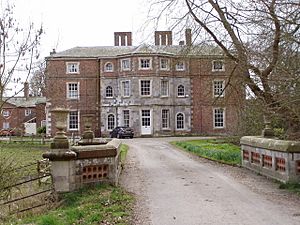William Strickland (navigator) facts for kids
William Strickland (died 8 December 1598) was an English landowner. He went on early trips to the Americas and is known for bringing the turkey to England. Later in his life, he became an important Puritan Member of Parliament.
Contents
Who Was William Strickland?
William Strickland was the son of Roger Strickland, a gentleman from Yorkshire, England. He likely came from a smaller branch of the Strickland family of Sizergh.
Early Adventures and the Turkey
When he was young, William Strickland sailed to the New World. He was one of Sebastian Cabot's assistants. People generally believe he was the first person to bring the turkey to England. This idea was so well-known that when he received his own coat of arms in 1550, it included a "turkey-cock." This official drawing of his crest is thought to be the oldest European picture of a turkey.
Life Back Home
Strickland came back to Yorkshire in 1542. He used the money from his travels to buy land in Wintringham and Boynton. He lived most of his life at Place Newton in Wintringham, where he is buried. However, he had the old Norman manor house at Boynton rebuilt into Boynton Hall. This became the main home for his family for many years. The church in Boynton has many decorations with the family's turkey crest. One special item is a lectern (a stand for books) carved like a turkey instead of the usual eagle. The turkey's tail feathers hold up the Bible.
William Strickland's Time in Parliament
In 1558, William Strickland was chosen to be a Member of Parliament (MP) for Scarborough. He was a strong and clear speaker for the Puritan cause. His political rivals even called him "Strickland the Stinger."
Standing Up for Parliament
Strickland became more important in the Parliament that met in 1571. During this time, the Puritan group was stronger than before. He found himself in the middle of a big constitutional crisis. This was one of Parliament's first times strongly saying it had the right to work without the Queen interfering with its members.
On April 7, 1571, Strickland suggested bringing back six bills to change the Book of Common Prayer. These bills had failed in the last Parliament. The Speaker allowed the bills to be read. However, Queen Elizabeth I had told Parliament not to discuss such topics. This led to a warning from the Queen.
Then, on April 14, 1571, Strickland introduced his own bill to change the prayer book. It suggested getting rid of confirmation, stopping priests from wearing special vestments, and ending the practice of kneeling during Communion. The bill was read for the first time, even with strong opposition from the Queen's advisors. After more discussion, the House voted to ask the Queen for permission to keep talking about the bill.
A Challenge to Royal Power
After this, Strickland was called before the Queen's advisors, the Privy Council. It seems he was told he could not go back to Parliament. When Parliament met again, members were upset that an MP was stopped from attending without Parliament's own order. They debated for most of the day, demanding that Strickland be allowed to return. The Queen's advisors discussed the matter. The next day, Strickland came back to Parliament. The other members showed their happiness by choosing him for an important committee.
Strickland was not re-elected right away after Parliament ended in 1572. But he was chosen again as MP for Scarborough in 1584.
Strickland's Family
William Strickland married Elizabeth Strickland, who was the daughter of Sir Walter Strickland from Sizergh. They had five children. Their oldest son, Walter, became William's heir. Walter's first son, also named William, was born just before his grandfather died. He also became a Member of Parliament and was given the title of baronet (of Boynton) in 1641.
Images for kids



